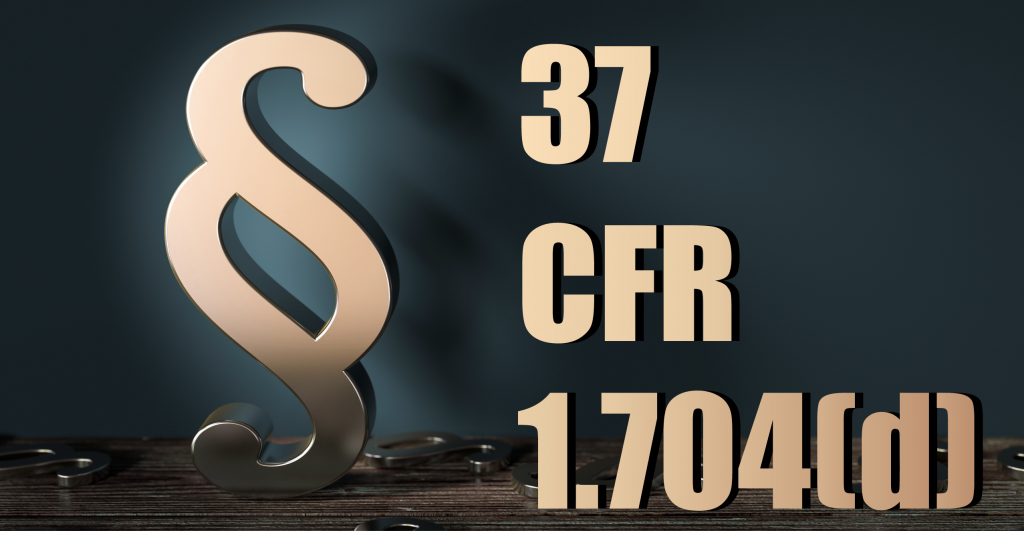Tips to Avoid Reductions to PTA When Citing Documents from Foreign Office Actions
- August 1, 2019
- Posted by: Lauren A. Pogue
- Category: Blog
 Patent term adjustment (PTA) is awarded by the USPTO to extend the term of patents to account for delays due to failure of the PTO to timely respond to Applicants. Applicant delays take away time accrued from PTO delays. PTO delays include failure to commence prosecution within 14 months of filing the application, failure to respond to Applicants within four months after a reply to Office Action is submitted, etc. Applicant delays include failure to respond to an Office Action within three months (37 CFR 1.704(b)), filing a supplemental paper after filing a response (37 CFR 1.704(c)(8)), filing a paper after receipt of a Notice of Allowance (37 CFR 1.704(c)(10)), etc.
Patent term adjustment (PTA) is awarded by the USPTO to extend the term of patents to account for delays due to failure of the PTO to timely respond to Applicants. Applicant delays take away time accrued from PTO delays. PTO delays include failure to commence prosecution within 14 months of filing the application, failure to respond to Applicants within four months after a reply to Office Action is submitted, etc. Applicant delays include failure to respond to an Office Action within three months (37 CFR 1.704(b)), filing a supplemental paper after filing a response (37 CFR 1.704(c)(8)), filing a paper after receipt of a Notice of Allowance (37 CFR 1.704(c)(10)), etc.
The PTO considers an information disclosure statement (IDS) as a “paper” that can constitute Applicant delay if filed during any of the “blackout periods” defined by the PTO in paragraphs 37 CFR 1.704(c)(6), (c)(8), (c)(9), or (c)(10).
However, there is a caveat provided for IDS’s filed citing only information from foreign communications if the IDS is filed within 30 days from receipt of the foreign communication by an individual designated in 37 CFR 1.56(c).
Specifically, 37 CFR 1.704(d) provides that a paper containing only an IDS in compliance with 37 CFR 1.97 and 1.98 will not be considered Applicant delay under paragraphs 1.704(c)(6), (c)(8), (c)(9), or (c)(10) if it is accompanied by a statement that each item of information:
(i) was first cited in any communication from a patent office in a counterpart foreign or international application or from the Office, and this communication was not received by an individual designated in 37 CFR 1.56(c) more than thirty days prior to the filing of the information disclosure statement; or
(ii) is a communication that was issued by a patent office in a counterpart foreign or international application or by the Office, and this communication was not received by any individual designated in 37 CFR 1.56(c) more than thirty days prior to the filing of the information disclosure statement.
Our Takeaway

With this in mind, it is best practice to cite foreign communications and/or documents cited in foreign communication within 30 days of receipt to avoid potential “Applicant delay,” which can adversely affect patent term adjustment (PTA). Even though foreign communications can be certified up to three months, the “Applicant delay” clock starts ticking after 30 days.
The above-mentioned “safe harbor” statement(s) should accompany the submission of the IDS and can be made using the SB/133 form available from the USPTO.
Tips to Follow
Importantly, Applicants should not confuse the checkboxes included on IDS form SB/08 to make certification statements under 37 CFR 1.97 and 1.98 with the separate 37 CFR 1.704(d) “safe harbor” statement required to prevent the IDS from being considered Applicant delay.
It is also important to note that if the IDS is filed without the safe harbor statement, it will be considered Applicant delay if filed during one of the “blackout periods,” even if the IDS otherwise meets the requirements of 37 CFR 1.704(d).
Applicants should also be aware that the automated system the USPTO uses to calculate PTA (PALM) cannot recognize when an IDS is filed with a safe harbor statement. Therefore, even if an IDS is filed with a safe harbor statement, it will be counted by the automated PALM system as Applicant delay.
It is prudent to monitor PTA calculations made by the PTO (provided by the PTO at the issue notification stage) carefully since they do not distinguish between IDSs filed by the 30 day deadline and those that aren’t.
While this is not a new issue, the PTO has decided to address this deficit in their next generation IT systems, currently in development. In the meantime, it has implemented a free interim procedure effective November 2, 2018 to request a recalculation of their PTA determination for alleged errors due to the PTO’s failure to recognize that an IDS was accompanied by a safe harbor statement. Click this link for more details on this procedure.
Authors
 David Woodward has been a patent attorney, procuring patents and counseling clients, for more than 25 years. As a former Examiner at the USPTO, David developed an appreciation of what approaches can be helpful to Examiners (and which are not) in prosecuting patent applications. As such, David is well-positioned to drafting new patent applications to ensure that they are in the best condition for examination in the PTO.
David Woodward has been a patent attorney, procuring patents and counseling clients, for more than 25 years. As a former Examiner at the USPTO, David developed an appreciation of what approaches can be helpful to Examiners (and which are not) in prosecuting patent applications. As such, David is well-positioned to drafting new patent applications to ensure that they are in the best condition for examination in the PTO.
 Sharla Flohr, Ph.D. is a patent agent who works with clients in the biotechnology, chemistry, and pharmaceutical fields to protect their valuable inventions by obtaining strong patent portfolios. Sharla believes in the importance of evaluating each invention to ensure patent applications are drafted and prosecuted with the client’s goals in mind.
Sharla Flohr, Ph.D. is a patent agent who works with clients in the biotechnology, chemistry, and pharmaceutical fields to protect their valuable inventions by obtaining strong patent portfolios. Sharla believes in the importance of evaluating each invention to ensure patent applications are drafted and prosecuted with the client’s goals in mind.
